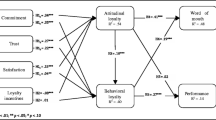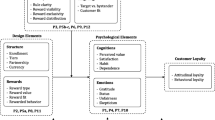Abstract
Loyalty in organizations has proved difficult to predict. One reason is that loyalty is complex and poorly understood. We report two studies that attempt to understand and predict loyalty by focusing on two components of the construct: active-constructive loyalty and passive-constructive loyalty. In the first study, we found that active acts of loyalty were predicted by variables quite different from those that predicted passive loyalty. The second study found that people identified by peers as high-loyalty employees performed many more active sets of loyalty than did those who were identified as low-loyalty employees. We conclude that loyalty consists of both active-constructive and passive-constructive behavior.
Similar content being viewed by others
References
Becker, H. S. (1960). Notes on the concept of commitment.American Journal of Sociology, 66, 32–40.
Brayfield, A. H., & Rothe, H. F. (1951). An index of job satisfaction.Journal of Applied Psychology, 35, 307–311.
Buss, D. M., & Craik, K. H. (1983). The act frequency approach to personality.Psychological Review, 90, 105–126.
Cooper, W. H., Dyke, L., & Kay, P. (1990) Developing act frequency measures of organizational behaviors. In Jauch, L. R., & Wall, J. L. (Eds.),Academy of Management Best Paper Proceedings, 396–399. San Francisco, CA: Academy of Management.
Farrell, D. (1983). Exit, voice, loyalty, and neglect as responses to job dissatisfaction: A multidimensional scaling study.Academy of Management Journal, 26, 596–607.
Graham, J. W. (1990, November). Hirschman's loyalty construct. Paper presented at the annual meeting of the Council on Employee Responsibilities and Rights. Orlando, Florida.
Graen, G. B., Liden, R. C., & Hoel, W. (1982). Role of leadership in the employee withdrawal process.Journal of Applied Psychology, 67, 868–872.
Hirschman, A. O. (1970).Exit, Voice, and Loyalty: Responses to Decline in Firms, Organizations, and States. Cambridge, MA: Harvard University Press.
Kolarska, L., & Aldrich, H. (1980). Exit, voice and silence: Consumers' and managers' responses to organizational decline.Organization Studies, 1, 41–58.
Porter, L. W., Steers, R. M., Mowday, R. T., & Boulian, P. V. (1974). Organizational commitment, job satisfaction, and turnover among psychiatric technicians.Journal of Applied Psychology, 59, 603–609.
Price, J. L., & Bluedorn, A. C. (1979). Test of a causal model of organizational turnover. In Dunkerley, D., & Salaman, G. (Eds.),International Yearbook of Organizational Studies, 217–236. London: Routledge & Kegan Paul.
Rotter, J. B. (1966). Generalized expectancies for internal versus external control of reinforcement.Psychological Monographs, 80, whole, No. 609.
Rusbult, C. E., Farrell, D., Rogers, G., & Mainous, A. G. III. (1988). Impact of exchange variables on exit, voice, loyalty, and neglect: An integrative model of responses to declining job satisfaction.Academy of Management Journal, 31, 599–627.
Withey, M. J., & Cooper, W. H. (1989). Predicting exit, voice, loyalty and neglect.Administrative Science Quarterly, 34, 521–539.
Author information
Authors and Affiliations
Rights and permissions
About this article
Cite this article
Withey, M.J., Cooper, W.H. What's loyalty?. Employ Respons Rights J 5, 231–240 (1992). https://doi.org/10.1007/BF01385050
Issue Date:
DOI: https://doi.org/10.1007/BF01385050




